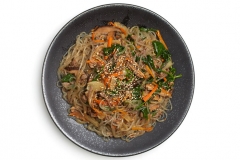Soy Sauce (regular) 왜간장

There are mainly two major types of soy sauce, and they are categorized by use: regular soy sauce and soy sauce for soup (Guk-Gan-Jang). The regular soy sauce is widely used in Korea and very similar to the soy sauce you see in Japan or North America. Soy sauce for soup, however, is unique to Korean cooking. As the name suggests, soy sauce for soup is mainly used for soup. But it is also used for “namul” (korean vegetable side dishes). Since it’s much saltier and lighter in color than regular soy sauce, you can use a small amount to season your soup while keeping the soup color nice and clear.
In addition to the two main soy sauces, another variation is called Mat-Gan-Jang (meaning “tasty soy sauce”). Mat-Gan-Jang is usually made by boiling regular soy sauce with different combinations of flavorful ingredients such as garlic, rice wine, sugar, lemon, mushroom or kelp, and then it’s saved for cooking various dishes.
Sourcing & Selecting
Local Korean grocery market
At CrazyKoreanShopping.com
You can buy Soy sauce online here.






















